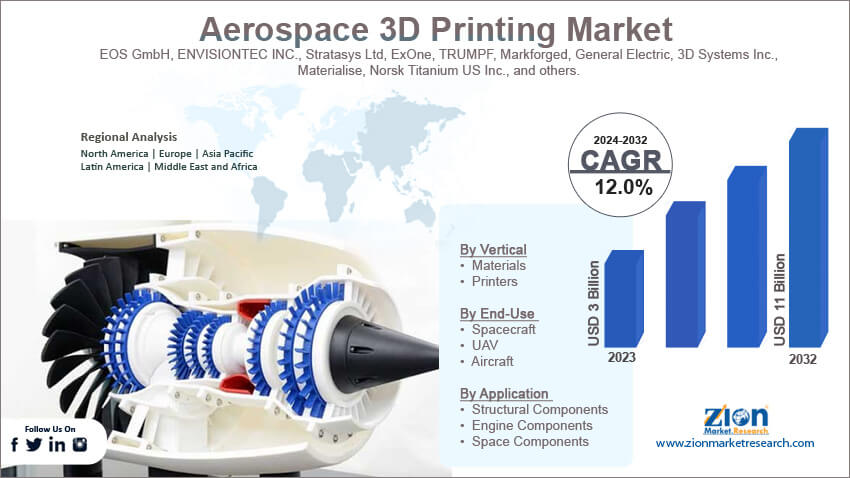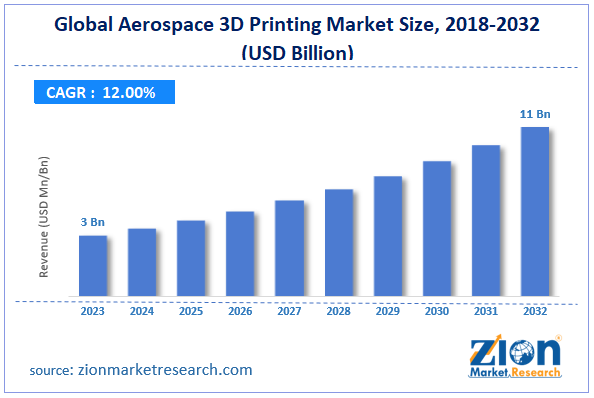Aerospace 3D Printing Market Size, Share, Industry Analysis, Trends, Growth, 2032

Aerospace 3D Printing Market By Vertical (Materials and Printers), By End-Use (Spacecraft, UAV, and Aircraft), By Application (Structural Components, Engine Components, and Space Components), and By Region - Global and Regional Industry Overview, Market Intelligence, Comprehensive Analysis, Historical Data, and Forecasts 2024 - 2032
| Market Size in 2023 | Market Forecast in 2032 | CAGR (in %) | Base Year |
|---|---|---|---|
| USD 3 Billion | USD 11 Billion | 12% | 2023 |
Aerospace 3D Printing Industry Prospective:
The global aerospace 3D printing market size was evaluated at $3 billion in 2023 and is slated to hit $11 billion by the end of 2032 with a CAGR of nearly 12% between 2024 and 2032.
Aerospace 3D Printing Market: Overview
Aerospace 3D printing is referred to as the use of additive manufacturing in the aerospace sector. The aerospace sector is the early user of 3D printing and derives the first mover advantage. For the record, firms in the aerospace sector started the use of 3D printing in 1989. For the record, the sector contributed nearly 16% of the 3D printing’s global earnings in 2015. Moreover, 3D printing is used in the aerospace sector for designing, validation, pre-production, production, and customization processes.
Key Insights
- As per the analysis shared by our research analyst, the global aerospace 3D printing market is projected to expand annually at the annual growth rate of around 12% over the forecast timespan (2024-2032)
- In terms of revenue, the global aerospace 3D printing market size was evaluated at nearly $3 billion in 2023 and is expected to reach $11 billion by 2032.
- The global aerospace 3D printing market is anticipated to grow rapidly over the forecast timeline owing to the growing demand for reducing the weight of aerospace parts with an aim of enhancing fuel efficiency and performance of aircraft.
- In terms of vertical, the materials segment is slated to register the highest CAGR over the forecast period.
- Based on end-use, the aircraft segment is predicted to contribute majorly towards the global industry share in the upcoming years.
- Based on application, the space components segment is predicted to dominate the application space in the upcoming years.
- Region-wise, the Asia-Pacific aerospace 3D printing industry is projected to register the fastest CAGR during the projected timespan.
 Request Free Sample
Request Free Sample
Aerospace 3D Printing Market: Growth Factors
Escalating need for lightweight aerospace components to upsurge the expansion of the global industry
Growing demand for reducing the weight of aerospace parts with an aim of enhancing fuel efficiency and performance of aircraft is anticipated to drive the growth of the global aerospace 3D printing market. The aerospace 3D printing provides customized components and can produce complex parts of airplanes on demand. This aspect is likely to boost the expansion of the market across the globe. An increase in the use of composites for 3D printing is anticipated to spur the expansion of the market globally. It brings efficiency to the supply chain activities along with helping in improving the aerospace designs that fulfill strict aerospace needs. This, in turn, will embellish the expansion of the global market.
Aerospace 3D Printing Market: Restraints
Rising costs of additive manufacturing can restrict the growth of the industry globally by 2032
A surge in the costs of 3D printing has prevented emerging economies from benefitting from its use, thereby restricting the expansion of the global aerospace 3D printing industry. Moreover, some of the firms in the aerospace sector have established their dominance and make use of the 3D printing process which can further impede the growth of the industry across the globe.
Aerospace 3D Printing Market: Opportunities
Growing necessity for product design improvement to generate new growth facets for the global market
3D printing helps in creating complex designs and lightweight structures in comparison to various other conventional manufacturing methods. This can open a slew of growth opportunities for the global aerospace 3D printing market. Escalating need for optimizing product designs and the necessity for bringing innovation in the aviation sector will prop up the growth of the market globally.
Aerospace 3D Printing Market: Challenges
Necessity of huge fund allocation for 3D printing processes can cause a ripple in the expansion of the industry globally
Need for huge initial capital investments and the tedious process of approving materials by authorities are a few of the aspects that can challenge the growth of the global aerospace 3D printing industry. Demand for process control can further inhibit the expansion of the global industry.
Aerospace 3D Printing Market: Segmentation
The global aerospace 3D printing market is divided into vertical, end-use, application, and region.
In terms of vertical, the aerospace 3D printing market across the globe is bifurcated into materials and printers segments. Additionally, the materials segment, which gained approximately 53% of the global market size in 2023, is expected to record the highest gains in the projected timeline. The segmental expansion over the analysis timeline can be due to a rise in the demand for strength-to-ratio components in the aerospace sector. Apart from this, the necessity of advanced materials in the aviation sector will further prop up the segmental expansion in the upcoming years.
Based on the end-use, the global aerospace 3D printing industry is divided into spacecraft, UAV, and aircraft segments. Moreover, the aircraft segment, which gathered approximately two-thirds of the global industry profits in 2023, is set to make lucrative contributions towards the global industry share in the coming decade. The growth of the segment in the forecasting years can be credited to an increment in the delivery of the aircraft along with the need for additive manufacturing techniques for designing these aircraft.
On the basis of application, the aerospace 3D printing market globally is sectored into structural components, engine components, and space components segments. Furthermore, the space components segment, which dominated the application landscape in 2023, is likely to continue this trend even in the foreseeable future. The segmental surge over the forecast period can be due to the rise in the use of aerospace 3D printing in space parts.
Aerospace 3D Printing Market: Report Scope
| Report Attributes | Report Details |
|---|---|
| Report Name | Aerospace 3D Printing Market |
| Market Size in 2023 | USD 3 Billion |
| Market Forecast in 2032 | USD 11 Billion |
| Growth Rate | CAGR of 12% |
| Number of Pages | 214 |
| Key Companies Covered | EOS GmbH, ENVISIONTEC INC., Stratasys Ltd, ExOne, TRUMPF, Markforged, General Electric, 3D Systems Inc., Materialise, Norsk Titanium US Inc., and others. |
| Segments Covered | By Vertical, By End-Use, By Application, and By Region |
| Regions Covered | North America, Europe, Asia Pacific (APAC), Latin America, Middle East, and Africa (MEA) |
| Base Year | 2023 |
| Historical Year | 2018 to 2022 |
| Forecast Year | 2024 - 2032 |
| Customization Scope | Avail customized purchase options to meet your exact research needs. Request For Customization |
Aerospace 3D Printing Market: Regional Insights
North America is expected to maintain its leadership status in the global market during the forecast timeline
North America, which contributed about 74% of the global aerospace 3D printing market revenue in 2023, is expected to establish a leading position in the global market in the upcoming years. Furthermore, the regional market expansion in the forecast timeline can be ascribed to an increase in the allocation of funds for 3D printing in the sub-continent. Additionally, the presence of key players in countries such as the U.S. will proliferate the regional market size in the years ahead.
Asia-Pacific aerospace 3D printing industry is slated to register the highest growth rate in the next few years. The quick industry expansion in the Asia-Pacific region can be due to the rise in the acceptance of 3D printing in the aviation sector in countries such as Japan, China, and India. Apart from this, the presence of key players in South Korea, Japan, and Taiwan will boost the growth of the industry in the APAC zone.
Key Developments
- In the first half of 2022, Materialise, a key player in 3D printing solutions, launched CO-AM, an open software tool that can effectively handle 3D printing production processes effectively.
- In January 2024, NASA introduced a metal 3D printer in space.
Aerospace 3D Printing Market: Competitive Space
The global aerospace 3D printing market profiles key players such as:
- EOS GmbH
- ENVISIONTEC INC.
- Stratasys Ltd
- ExOne
- TRUMPF
- Markforged
- General Electric
- 3D Systems Inc.
- Materialise
- Norsk Titanium US Inc.
The global aerospace 3D printing market is segmented as follows:
By Vertical
- Materials
- Printers
By End-Use
- Spacecraft
- UAV
- Aircraft
By Application
- Structural Components
- Engine Components
- Space Components
By Region
- North America
- The U.S.
- Canada
- Europe
- France
- The UK
- Spain
- Germany
- Italy
- Rest of Europe
- Asia Pacific
- China
- Japan
- India
- South Korea
- Southeast Asia
- Rest of Asia Pacific
- Latin America
- Brazil
- Mexico
- Rest of Latin America
- Middle East & Africa
- GCC
- South Africa
- Rest of Middle East & Africa
Table Of Content
Methodology
FrequentlyAsked Questions
Aerospace 3D printing is referred to as the use of additive manufacturing in the aerospace sector. The aerospace sector is the early user of 3D printing and derives the first mover advantage.
The global aerospace 3D printing market growth over the forecast period can be owing to aerospace 3D printing providing customized components and can produce complex parts of airplanes on demand.
According to a study, the global aerospace 3D printing industry size was $3 billion in 2023 and is projected to reach $11 billion by the end of 2032.
The global aerospace 3D printing market is anticipated to record a CAGR of nearly 12% from 2024 to 2032.
The Asia-Pacific aerospace 3D printing industry is set to register the fastest CAGR over the forecasting timeline owing to the rise in the acceptance of 3D printing in the aviation sector in countries such as Japan, China, and India. Apart from this, the presence of key players in South Korea, Japan, and Taiwan will boost the growth of the industry in the APAC zone.
The global aerospace 3D printing market is led by players such as EOS GmbH, ENVISIONTEC, INC., Stratasys Ltd, ExOne, TRUMPF, Markforged, General Electric, 3D Systems, Inc., Materialise, and Norsk Titanium US Inc.
The global aerospace 3D printing market report covers the geographical market along with a comprehensive competitive landscape analysis. It also includes cash flow analysis, profit ratio analysis, market basket analysis, market attractiveness analysis, sentiment analysis, PESTEL analysis, trend analysis, SWOT analysis, trade area analysis, demand & supply analysis, Porter’s five force analysis, and value chain analysis.
HappyClients
Zion Market Research
Tel: +1 (302) 444-0166
USA/Canada Toll Free No.+1 (855) 465-4651
3rd Floor,
Mrunal Paradise, Opp Maharaja Hotel,
Pimple Gurav, Pune 411061,
Maharashtra, India
Phone No +91 7768 006 007, +91 7768 006 008
US OFFICE NO +1 (302) 444-0166
US/CAN TOLL FREE +1 (855) 465-4651
Email: sales@zionmarketresearch.com
We have secured system to process your transaction.
Our support available to help you 24 hours a day, five days a week.
Monday - Friday: 9AM - 6PM
Saturday - Sunday: Closed






